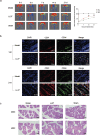LL37 promotes angiogenesis: a potential therapeutic strategy for lower limb ischemic diseases
- PMID: 40337519
- PMCID: PMC12055537
- DOI: 10.3389/fphar.2025.1587351
LL37 promotes angiogenesis: a potential therapeutic strategy for lower limb ischemic diseases
Abstract
Purpose: To study the angiogenic capacity of antimicrobial peptide LL37 (cathelicidin antimicrobial peptide), explore its molecular mechanisms, and provide new ideas for treating lower limb ischemic diseases.
Methods: LL37 was applied exogenously to human umbilical vein endothelial cells (HUVECs), and its effects on cell proliferation, migration, and angiogenesis were assessed using Cell Counting Kit-8 (CCK-8), plate cloning, scratch, and angiogenesis assays. A mouse lower limb ischemia model was established, with LL37 injected intramuscularly on days 0, 4, and 8. Blood flow recovery was evaluated by laser Doppler flowmetry. Immunofluorescence staining detected cluster of differentiation 31 (CD31) and cluster of differentiation 34 (CD34) expression, while Hematoxylin and Eosin (H&E) staining assessed muscle cell morphology. Quantitative real-time polymerase chain reaction (qRT-PCR) and Western blotting analyzed gene and protein expression changes in HUVECs.
Results: LL37 enhanced the proliferative, migratory, and pro-angiogenic abilities of HUVECs. It significantly improved blood flow recovery in ischemic limbs, with higher CD31/CD34 expression and more intact muscle morphology. qRT-PCR analysis demonstrated elevated expression of angiogenesis-related genes in LL37-treated HUVECs. Western blotting revealed increased vascular endothelial growth factor A (VEGFA) expression and enhanced phosphorylation levels of the phosphatidylinositol 3-kinase (PI3K)/protein kinase B (AKT)/mammalian target of rapamycin (mTOR) pathway in LL37-treated cells.
Conclusion: LL37 promotes angiogenesis via the VEGFA-PI3K/AKT/mTOR pathway, showing potential for treating lower limb ischemia by improving perfusion.
Keywords: LL37; VEGFA-PI3K/AKT/mTOR pathway; angiogenesis; antimicrobial peptide; lower limb ischemia.
Copyright © 2025 Yang, Wu, Wang, Mao, Zhang and Wu.
Conflict of interest statement
The authors declare that the research was conducted in the absence of any commercial or financial relationships that could be construed as a potential conflict of interest.
Figures




Similar articles
-
Integrative multi-Omics and network pharmacology reveal angiogenesis promotion by Quan-Du-Zhong Capsule via VEGFA/PI3K-Akt pathway.J Ethnopharmacol. 2025 Jan 31;340:119222. doi: 10.1016/j.jep.2024.119222. Epub 2024 Dec 6. J Ethnopharmacol. 2025. PMID: 39647590
-
[Mechanism of astragaloside Ⅳ combined with Panax notoginseng saponins in regulating angiogenesis to treat cerebral ischemia based on network pharmacology and experimental verification].Zhongguo Zhong Yao Za Zhi. 2024 Feb;49(4):1017-1027. doi: 10.19540/j.cnki.cjcmm.20230901.401. Zhongguo Zhong Yao Za Zhi. 2024. PMID: 38621909 Chinese.
-
Silent Information Regulator 1 Negatively Regulates Atherosclerotic Angiogenesis via Mammalian Target of Rapamycin Complex 1 Signaling Pathway.Am J Med Sci. 2018 Aug;356(2):168-176. doi: 10.1016/j.amjms.2018.04.010. Epub 2018 Apr 25. Am J Med Sci. 2018. PMID: 30219159
-
Dapagliflozin Improves Angiogenesis after Hindlimb Ischemia through the PI3K-Akt-eNOS Pathway.Biomolecules. 2024 May 16;14(5):592. doi: 10.3390/biom14050592. Biomolecules. 2024. PMID: 38785999 Free PMC article.
-
Low-level laser therapy induces human umbilical vascular endothelial cell proliferation, migration and tube formation through activating the PI3K/Akt signaling pathway.Microvasc Res. 2020 May;129:103959. doi: 10.1016/j.mvr.2019.103959. Epub 2019 Nov 14. Microvasc Res. 2020. PMID: 31734375
References
-
- Adamičková A., Chomaničová N., Gažová A., Maďarič J., Červenák Z., Valášková S., et al. (2023). Effect of atorvastatin on angiogenesis-related genes VEGF-A, HGF and IGF-1 and the modulation of PI3K/AKT/mTOR transcripts in bone-marrow-derived mesenchymal stem cells. Curr. Issues Mol. Biol. 45 (3), 2326–2337. 10.3390/cimb45030150 - DOI - PMC - PubMed
LinkOut - more resources
Full Text Sources
Miscellaneous

